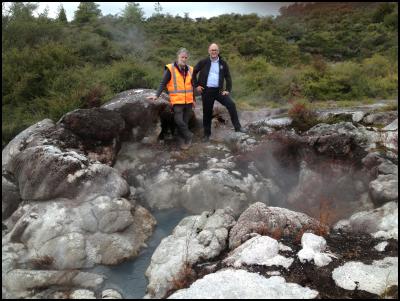Dormant Whakarewarewa geyser springs into life
12 October, 2013
Dormant Whakarewarewa geyser
springs into life

A Te Whakarewarewa Valley geyser that has been dormant for nearly 35 years has sprung into life in recent weeks, signifying the first regeneration of a Te Whakarewarewa Valley geyser since Rotorua’s bore closure programme was implemented between 1986 and 1992.
Located near the world-famous Pohutu Geyser, Papakura was historically known as one of the highlights of a visit to Whakarewarewa Valley. The geyser was named after famous Te Arawa guide, Maggie Papakura.
Papakura had been a consistently active geyser until March 1979. The failure of Papakura geyser marked a turning point in the understanding of the damage that the bore use was having on springs and geysers. The area has been hidden by vegetation for many years, but was uncovered by Te Puia|NZMACI maintenance staff last year.
In mid-September, bubbling water was sighted coming from the area, and on Sunday 29 September, there was a series of small “eruptions”, where steam and water were measured shooting up to a metre high in the air.
GNS Science volcanologist, Brad Scott, says the geyser’s reinvigoration is a significant development for the region’s geothermal fields, and is the first sign of renewed life in Te Whakarewarewa Valley since Rotorua’s bore closure programme was implemented.
“Until Papakura became dormant in 1979, she was one of the most consistent geysers in the valley, only stopping once before during a significant drought in the 1930s. As a result, when her activity ceased, it was a very clear signal that the area’s geothermal resources were being depleted.
“Since the bore closure programme was implemented, we have seen a small resurgence in geothermal activity in recent years in areas such as Kuirau Park, Tawera Rd and the Government Gardens, however, this is the first such development in Te Whakarewarewa Valley – an area that is internationally renowned for its geothermal activity.”
Mr Scott says the water temperature within Papakura had been rising steadily for some time, however the geyser’s overflow was a significant milestone.
“It is a significant and reassuring development for the geothermal field,” says Mr Scott.
Te Puia Chief Executive, Tim Cossar, says Papakura’s recent activity is an exciting development for Te Puia staff and visitors, as well as for local iwi who have made the valley their home for hundreds of years.
“Historically, Te Whakarewarewa’s Māori culture and geothermal activity were real attractions for visitors to the valley, and the Papakura Geyser was one of the highlights. Had she not become dormant in the late 1970s, there is every chance she would have been as well known as Pohutu.
“Today, Rotorua is still internationally renowned for its geothermal activity, with the Pohutu Geyser being one of the most photographed attractions in Rotorua”.
“Our geothermal activity is a real asset to our region and our tourism economy, and it is rewarding for everyone involved that the measures that were taken 30 years ago are starting to pay off with some of our natural features starting to come back to life.”
“We are mandated by an Act of Parliament to maintain and preserve traditional Māori art forms, but under that legislation we also have a clear responsibility to ensure the sustainability of the remarkable geothermal landscape and the natural environment that exists in Te Whakarewarewa Valley. This is a responsibility that we take seriously.”
Mr Cossar says manuhiri (visitors) to Te Puia will be able to view Papakura from existing pathways.
“All of the significant geothermal activity in the valley is fenced off to ensure the safety of our manuhiri and staff, however, Papakura can be easily viewed from existing paths and viewing areas.
“She has been bubbling continuously for a few weeks now and that is encouraging, and while we can’t make any promises about any significant additional activity, manuhiri will still have a unique experience if they choose to visit.”
Te Puia is located on the Southern Arikikapakapa and Whakarewarewa Thermal Reserves, on land leased from the Whakarewarewa Joint Trust. The land is jointly owned by Ngati Whakaue and Ngati Wahiao.
Chairman of the Whakarewarewa Joint Lands Trust Malcolm Short, says this is a remarkable recovery of a previous tourist icon in the Whakarewarewa thermal valley.
“It shows the cyclical nature of our geothermal field which is so dependent on groundwater levels. This has happened across our geothermal fields in the past and will happen again in the future.”
-ends-


 Antarctic Heritage Trust: NZ-made ‘Cutting-Edge’ VR Experience Tours The UK
Antarctic Heritage Trust: NZ-made ‘Cutting-Edge’ VR Experience Tours The UK Brian Gaynor Business Journalism Initiative: Brian Gaynor Initiative Business Journalism Funding Award Moves To Rolling Applications
Brian Gaynor Business Journalism Initiative: Brian Gaynor Initiative Business Journalism Funding Award Moves To Rolling Applications  Inland Revenue: Fifth Anniversary Of The SBC Loans - Time To Repay
Inland Revenue: Fifth Anniversary Of The SBC Loans - Time To Repay Te Runanga o Ngati Hinemanu: First Marae Based Fresh Water Testing Science Lab Grand Opening 16-17 May 2025
Te Runanga o Ngati Hinemanu: First Marae Based Fresh Water Testing Science Lab Grand Opening 16-17 May 2025 Raise Communications: NZ Careers Expo Kicks Off National Tour Amid Record Unemployment
Raise Communications: NZ Careers Expo Kicks Off National Tour Amid Record Unemployment Hugh Grant: How To Build Confidence In The Data You Collect
Hugh Grant: How To Build Confidence In The Data You Collect